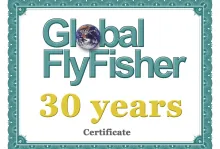Just the other day the Global FlyFisher crossed the 50,000 node nid mark in the database. GFF is a large site, but still far from any boundaries set by Drupal.
Nerd alert
This is NOT about fly fishing or fly tying, but about site development and nerdy stuff.Drupal's base content unit is a node. A node is essentially a content element of any content type. On GFF we have a number of node types, mainly articles, blog entries and reviews, which you'd recognize as the very thing that they represent: text pages on the site.
But we also have other node types like pictures and videos, each representing still images and videos of course and also shown as separate pages when you click a thumb in an article or in the video section.
But the way Drupal is built makes in logical to have many other content or node types such as wallpapers, patterns, tying cribs, user pictures, newsletters, podcasts, series/shows and episodes, themes and a few more.
Splitting content up in types makes good sense since they have varying characteristics and need various types of content fields.
A review needs a publisher, a price, a rating and such, which an article doesn't.
A podcast needs a sound file.
A wallpaper needs several attached, downloadable image files.
A picture needs one file, which displays.
A theme needs links to a selection of other content and so on.
Basically they are all the same core construct and are stored in one big pile internally. Drupal separates them by selecting them based on different criteria where the type can be one, but tags (keywords) could be another and author could be a third. Since the basic selection and presentation is the same, the different content types can essentially be mixed and matched for different purposes, like building a theme, a section page, a newsletter or whatever.
| picture | 15,502 |
| video | 9,087 |
| pix | 3,602 |
| article | 1,445 |
| pattern | 678 |
| forum | 606 |
| blog | 409 |
| review | 339 |
| wallpaper | 112 |
And as I said: just the other day GFF passed node number 50,000. That may sound like a lot, but is nothing compared to what the system can handle. In my day job I have made sites, which handled ten times as many, and many Drupal sites out in the wild contain millions of nodes. There's a limit of course, but that runs into the billions - 4,294,967,295 to be exact. Few sites will challenge that limit, I think.
Even though the node number - the nid as it's called in Drupal, the id of the node - passed 50,000 there are still only about 32,000 individual nodes in the database. Drupal doesn't necessarily number them in sequence and some have been deleted underway, so there are holes in the sequence.
Node number 50,000 happened to be a picture by the way: /node/50000. Node numbers are usually hidden to the readers since Drupal offers to give the somewhat bland and nondescript node/nid address an alias, in this case /picture/it-bends-it-stretches-it-springs
Accessing content by node number still works fine, though. node/1 is a test post and hidden to the public, node/100 is a forum post, node/1000 is a video and node/10000 doesn't exist.
So with a measly 30,000 or so nodes under its belt, the Global FlyFisher chugs on, growing steadily, and will not hit any ceiling anytime soon. It might be a big site, but it's definitely a dwarf compared to many Drupal sites out here.
- Log in to post comments








